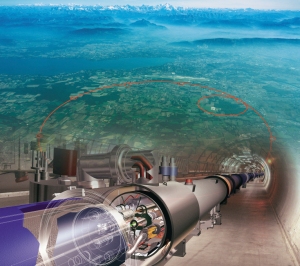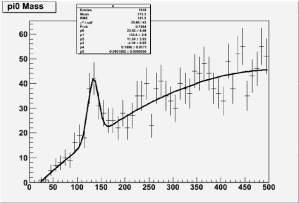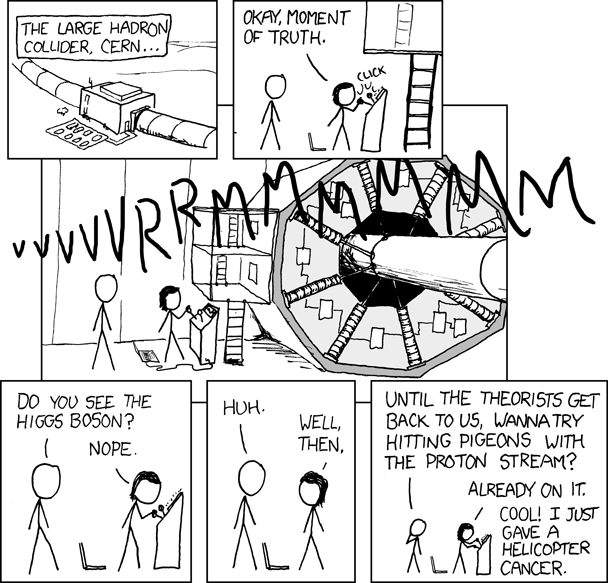 The Large Hadron Collider never felt real.
The Large Hadron Collider never felt real.
For several years I was a high-energy particle theorist. I wanted to know how to experimentally test wild questions: Are there tiny curled up extra dimensions? Where do the masses of the elementary particles come from? Which laboratory has the best cafeteria? The answer to all of those was supposedly going to be in Geneva, Switzerland — at CERN where the Large Hadron Collider, the LHC, was being built. The highest energy machine ever! It would answer all our questions! The on-site cafes serve wine!
But it was far away, five years and ten thousand miles when I started grad school, at the Stanford Linear Accelerator Center, in Menlo Park, California. It was sunny, and we had a collider. You can see it stretching away, an impossibly long building, as you drive northbound on I-280, about midway between San Jose and San Francisco. It was spectacularly real, but unfortunately didn’t produce data relevant to the questions I wanted answered.
Like all research groups, the theorists would go as a group to eat lunch in the SLAC cafeteria, where quality was a distinctly relative attribute. The salad bar was a disgrace to Northern California, but the SLAC-burger was passable. The conversation at the table rarely strayed from physics (as long as you count gossip about physicists in that category). The LHC would come often come up, and rarely with good news. The company responsible for the magnets was taking too long, or a failed test meant at least 6 months delay; the already distant collider receding farther away.
Colliders are machines that are built to find particles. There are the familiar ones like electrons and quarks and photons (atoms are made of those three types), but there are many others. New discoveries are generally new particles, or at least can be interpreted that way. Here’s one way it can get fuzzy: if there are tiny, curled up extra dimensions, then it’s possible that particles can spin around in them. But, due to the apparent absurdities of quantum mechanics, the smaller a circle that something spins in, the larger the energy it has to have. Energy is mass, which means particles spinning around an extra dimension are heavy. So what you do is this: you look for a very massive particle that otherwise behaves exactly like one of the particles we already know everything about, like a gluon, and you look for it in a collider. If you find it, you’ve found an extra dimension.
The LHC was a collider that existed for me as a phrase repeated in conversation, a line drawing in a design report, and most often as an option in a computer program. I’d be running my simulations on how to find a gluon spinning around an extra dimension and I’d set a switch in the program. Select collider: 1 for the Tevatron, 2 for the LHC. We’d do our simulations with option 2 and look at the output and say: “The LHC will be able to find this particular kind of extra dimension”. But that couldn’t be true until the machine was on, so the sentence never carried the excitement it should have. If it was a Wednesday we might get a little more excited, since that was Burrito Day, but mostly there was the feeling of, “Well, now we know that, but it will be years before we can really test it. What’s next?”
The Tevatron felt real. I’d been to Fermilab, in Batavia, Illinois (only a few miles from Geneva, Illinois) and walked the two miles around the ring. Fermilab had the one cafeteria where you could get sushi. It was the sad little rolls in black plastic trays with that dob of wasabi and the tiny puddle of soy sauce, but it was sushi. The experimenters from the Tevatron detectors would often come through the theory offices with printouts of new data and we’d all gather round and fawn over the plots. There were beautiful lines with bumps and error-bars. Each bump is a particle, a part of nature; the ever-shrinking error-bars tracked our increasing certainty that they really were there. But when we selected option 1 the plots always told us the Tevatron wouldn’t be able to see the kinds of extra dimension that we thought might exist. There would be no bumps in their data corresponding to gluons spinning around in extra dimensions. It was real, but not helpful.
A particle has a definite relationship between it’s energy and it’s momentum, and what relates them is its mass. The momentum can point in any direction, but it’s magnitude has to be a particular value, so the allowed momenta form a sphere, or rather a shell, in space — a ‘mass-shell’. Quantum mechanics allows particles to violate this relationship briefly, to not be quite real, their energy and momentum not quite matched. These ‘virtual’ particles are off their mass-shell, or just off-shell. They can’t venture away from the safety of the shell for long. Any virtual particle must soon either fade back into the vacuum or strike another particle in a way that pushes it on-shell.
Clearly, the LHC existed, but far off-shell. Scientists and engineers were spending a tremendous amount of time working on it. It was central to my own research, I thought about it every day in way or another; I made plot after plot of simulated data, and saw hundreds more from other people. We wanted to find extra dimensions! Or Supersymmetry, or anything new. But as the years went on and the delays kept coming it felt like it would always exist in a state of being built, not of actually working. It was a virtual machine, and not finding the right path to its mass-shell.
I left academia a bit over a year ago. I live in New York City, surrounded by spectacularly good restaurants. A couple days ago I woke up and poured myself a bowl of frosted mini-wheats only to find that the LHC had finally succeeded in colliding beams. The machine was functioning. After 25 years of planning and building — 7 years since I learned about it and started my personal wait — it’s on. Yet somehow even that wasn’t enough. That night I had store-bought hummus and crackers for dinner and stared at an event display from the ATLAS experiment, tracing out the paths of the debris from the collision. I wanted to think it was real, but I felt something was missing.
I eat my breakfast standing in the kitchen, reading news on my laptop. This morning I stood there and saw what I was missing. One of the experiments, LHCb, looked for a neutral pion. That’s a very common type of particle. Discovered in 1950, there can be hundreds of them in a single collision. They’re used for calibrating detectors and probing other particles. But the LHC, like all colliders at the energy frontier, has to start at the beginning. It has to show that it can re-discover all the particles that we know before it can find the ones we don’t. I’ve run out of cereal, so all I have this morning is coffee. I’m on my third cup when I find a plot of the search for the neutral pion. It looks just like the ones from the Tevatron. The error bars are big and the bump is a particle we’ve known about for 60 years, but there it is, an on-shell plot from an on-shell machine.
 Tonight I’m going to walk a bit farther down the street from the grocery store, skip the cookies and hummus, and get take-out from Caracas, the city’s best arepa restaurant. Maybe I’ll open a bottle of Champagne and toast to the reality of the LHC, or maybe I’ll just smile a little for it and wait for the bumps we haven’t seen before.
Tonight I’m going to walk a bit farther down the street from the grocery store, skip the cookies and hummus, and get take-out from Caracas, the city’s best arepa restaurant. Maybe I’ll open a bottle of Champagne and toast to the reality of the LHC, or maybe I’ll just smile a little for it and wait for the bumps we haven’t seen before.
